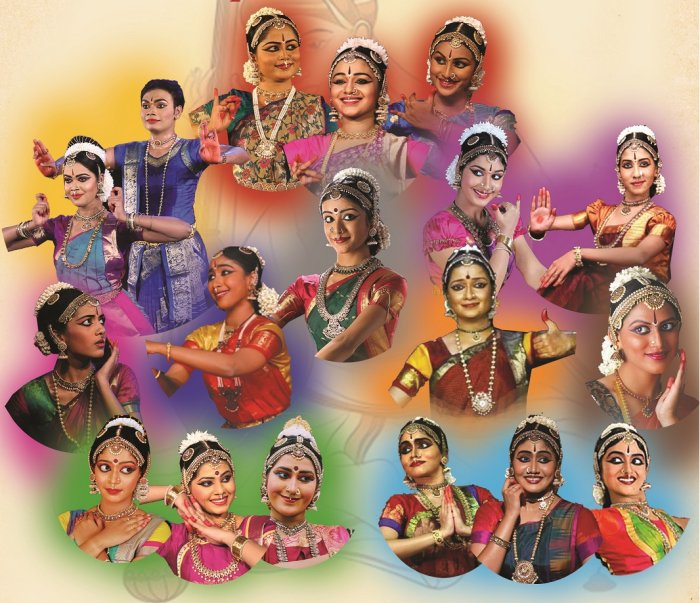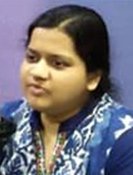
|   |

|   |
Fitting tribute to Tyagaraja - B. Naveena e-mail: naveena_b_2002@yahoo.co.in February 13, 2021 When a literary masterpiece is to be given a visual adaptation, it becomes a double-edged sword. While there is the definite advantage of the audience being familiar with the content, there is always the onus of conveying intact the spirit of the original. Adapting a Tyagaraja composition to dance poses the same challenge, being the literary, musical and devotional masterpiece that it is. The Tyagaraja Utsav organised by Chennai-based organisation Kalapradarshini (Founder: Parvati Ravi Ghantasala) marked the Silver Jubilee of the organisation's annual tribute to Tyagaraja. Though showcasing the Pancharatnas of Tyagaraja has been their practice since inception, this year, they chose to exhibit a string of his compositions presented by 20 disciples of senior and promising gurus. The performances were recorded in an auditorium while being performed to a live orchestra, hence the acoustics and lighting were impeccable. The event was streamed in 2 parts on the evening of Feb. 2, '21-the day of Tyagaraja Aradhana. The Tanjore-style painting of a cheerful, young Tyagaraja was a captivating addition to the stage.  Part 1: The opening piece was 'Shri Ganapatini' (Saurashtram, Adi), presented by Manasa Vijaychander and Gowthami Ashok, disciples of Radhika Shurajit. Entering on opposite sides of the wings, to a solkattu in the same raga and gait as the song, the dancers were in fine form and the choreography did justice to the Nartana Ganapati envisaged by the saint. Even small touches like the breaking of the soorakai (coconut) were executed with classicism and the inner meaning of this ritual i.e., banishing one's worries was shown. Gowthami's expressions showed involvement. Their costumes in magenta and gold were pleasing. 'Nagumomu' (Abheri, Adi) was presented by the students of Anitha Guha-Anjali Hariharan, Smrithy Krishnamoorthy and Nutana Nair. Though the song they chose centred around a devotee pining for the Lord, their costumes seemed a riot of colours, somehow not in sync with the melancholic sentiment of the song. The vocalist pronouncing the 'gu' in Nagumomu like the 'gu' in 'azhagu' seemed a bit jarring (while the authentic pronunciation would be like the 'gu' in 'guna'). A few interesting formations and poses, involved expressions and judicious use of the small performing space were the assets of this presentation. Disciples of Binesh Madhavan-J.R. Janani, Deepanjali Sureshkumar and S. Malarvili presented 'Ksheerasaagara Shayana' (Devagandhari, Adi). In keeping with the lyrics, several episodes were depicted, like Rama crossing the bridge, Draupadi in Duryodhana's court, etc. Though the Gajendramoksha episode seemed a repetition as it was performed just minutes ago by the previous troupe, the choreography did not induce deja vu. Their costumes were in a pleasant yellow and green. The sole soloist of Part 1 was Sneha Mahesh, pupil of Priya Murle. The choreography interestingly included the allusion to Rama tending to the wounded Jatayu and granting him emancipation, as an interpretation of the opening word, 'Brochevarevare' (Sriranjani, Adi). The piece was peppered with swara suites and jatis, which brought about the feel of a varnam. One felt the talented dancer needed to induce more impact when portraying the duel between Sugreeva and Vali. The vocalist Nandini Sharma Anand provided superb music for all the four pieces, accompanied by sensitive playing by Dhanamjayan (mridangam) and Vishwesh (violin). Since the same team played for all the artistes in this part, their introduction after every piece was redundant.  Part 2: This opened with Parvathi's pupils, namely Vallabhi Chellam, Gayathri S. and Thejaswini S. The piece they presented was 'Shrirama Shrirama' (Sahana, Adi). The composer beseeches the Lord to shower His compassion on him and gently questions His indifference to his pleas. The dancers were well-trained and their lines were clean. But the fast pace of the moving song and the inclusion of a joyous bhajan-like step, seemed a wee bit out of place, since the song was an entreaty. The phrase, 'Pankaja vadanama' (One whose face is akin to a lotus) was mispronounced several times as 'Pankaja dala naama' (One whose name is that of a lotus-petal!), though the interpretation in dance was accurate. Saishruthi Krishnaswamy (disciple of Mahalakshmi Ashwin) presented 'Sri Raghuveera' (Kambhoji, Adi), weaving several swara passages. She was one of the soloists in this segment. She is also well-trained and hard-working, but certainly needs to smile, emote and enjoy her performance more. For the most part, she was wearing a stern and petulant expression which did not convey the myriad shades of the narratives she briefly depicted viz., Ahalya's curse and Sita Swayamvaram. The two Kuchipudi artistes who presented next were Daphnie and Dilip, students of Sailaja. 'Ela nee dayaraadu' (Athana, Adi) had many of the laudable elements that one would associate with Dr. Vempati Chinna Sathyam's choreography, since the artistes belong to that school. But the choreography for the phrase, 'Raa raa devaadideva', replicated the come-hither coquettish glances and movements of the famed 'Swami raa raa' phrase in the Krishna Shabdam of the Kuchipudi repertoire, proving an appalling misfit, as the context is purely devotional in a Tyagaraja kriti. Dilip should endeavour to improve his expression and get rid of the slight effeminateness that crops up occasionally. Rukmini Inturi, tutored by Indu and Nidheesh presented 'Nidhi chaala sukhamaa' (Kalyani, Mishrachapu), aided by aesthetic and thoughtful choreography which showed clearly the contrasts spelt out by Tyagaraja-material pleasures versus devotion towards Rama, the pure river of self-control as opposed to the quagmire of worldly pursuits, and lastly, the sycophancy to a human versus panegyrising Rama. Rukmini's expressions were apt and showed maturity. Vocalist Kaushik deserves special plaudits for his lovely rendition of Kalyani. The choice of the item of the next dancer, Ritvika Rajesh, protégé of Urmila Sathyanarayana, was 'Seeta Kalyana Vaibhogame' (Kurinji, Khandachapu), a staple in wedding festivities. Ritvika has a charming stage presence and entered to jatis recited initially in a robust manner, seemingly to convey the heaviness and majesty of Shiva's bow, whose stringing was the litmus test for the suitor. The tone of the jatis aptly morphed into softness when depicting Seetha, and attained staidness when Rama was being indicated. Short yet sparkling, the rhythmic passages did not affect the beauty of the song and infused joie de vivre. Ritvika was delightful in nritta and showed great sensitivity in abhinaya. She only needs to use the performing space a bit more. The fierce depiction of Hanuman for the line, 'Pavanaja-stuti-paatra..' seemed rather inappropriate. Sahana Selvaganesh was the final presenter, her guru being Roja Kannan. 'Nanu Paalimpa' (Mohanam, Adi) was the kriti chosen by her. The artiste displayed great involvement in the abhinaya aspect throughout and savoured each of the incidents in which Rama is said to have 'walked', as the saint describes him. While walking with Vishwamitra to protect his yaga, while freeing Ahalya from the curse, while emancipating Jatayu, Rama's compassion towards those who seek Him were portrayed convincingly. Her costume seemed to reflect Rama's complexion, thoughtfully! Haribabu (mridangam) and Kalaiarasan (violin) were the able accompanists for the entire second segment. Kaushik was the vocalist for all the artistes except Sahana, for whom vocal was rendered by Parur Ananthasree. Nattuvangam for all the artistes was by their respective gurus. It is no mean task to mount an impressive festival for 25 consecutive years. Parvati Ravi Ghantasala is truly deserving of praise for being the curator, while also for preparing her students to participate. However, a few friendly observations/suggestions: The imbalance in the segments needs to be rectified, to negate tedium in viewing. No doubt, both were crisply edited. The first segment showcasing 4 artistes lasted about 45 mins and seemed a breeze to watch. But the second segment, lasting nearly 70 mins featured 6 artistes, with most of them handling bellwether compositions in the vilamba/chauka kaala. Agreed, that one may watch at one's convenience given the e-platform. But for eager beavers who want to catch the premieres, it does become overwhelming to dedicate more than 2 hours to passive viewing. Juxtaposing the heavy kritis with the fast ones, or pruning the number of participants count among the solutions. As indicated earlier, the accompanists could be announced at the beginning or end of the segment once, instead of at the end of every item.  Naveena holds an M.B.A. in Human Resources and an M.A. in Samskrtam. She speaks and writes on language and the fine arts. She enjoys being a translator, singer, linguist and quizzer. |